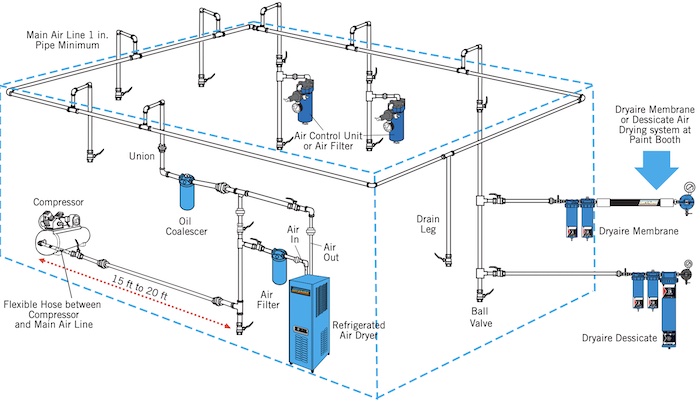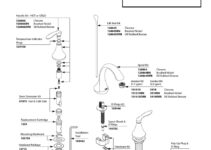Shop air refers to the compressed air that is used in a workshop or industrial setting for various purposes such as operating pneumatic tools, cleaning surfaces, or inflating tires. This air is typically supplied by an air compressor and may be regulated by a control panel or other system to ensure proper pressure and flow.
Knowing the right steps to take during the piping process is important with this setting. In this article, we have provided an accurate Shop Air Compressor Piping diagram as well as the details to help with proper setup and use
Shop Air Compressor Piping Diagram & Details
Below is a diagram of a standard Shop Air Compressor Piping setting.

Shop Air Compressor Piping Components Explained
Ball Valve
A ball valve in the shop air compressor piping setting is a type of valve that controls the flow of compressed air through the piping system. It consists of a spherical ball with a hole or passageway through the center, which is rotated to open or close the flow of air.
The ball valve is commonly used in shop air compressor systems to regulate the flow of air to various tools and equipment and to shut off the flow of air when necessary.
Union
The union in the shop air compressor piping setup is a type of fitting that allows for easy connection and disconnection of two sections of piping without having to disassemble the entire system.
This allows for easy maintenance and repair of the air compressor and the piping system. It consists of two flanges that are connected by a nut and bolt and is sealed with a gasket to prevent air leakage.
Compressor
The compressor in a shop air compressor piping system is the mechanical device that pressurizes and pumps air into the system. It typically consists of a piston, cylinder, and valves, and uses mechanical energy to compress and pump the air into the piping system. This provides the necessary pressure for powering tools and other air-powered equipment in the shop.
Stand Pipe
A standpipe is a vertical pipe that is used in the piping system of a shop air compressor. It is typically installed near the compressor and serves as a connection point for other components in the system, such as air hoses, filters, and regulators. The standpipe allows for easy access and maintenance of these components and helps to regulate the flow of compressed air in the system.
Air Filter
The air filter in a shop air compressor piping system is a device that removes impurities and contaminants from the air before it is compressed and sent to the tools and equipment being used. It helps to ensure that the compressed air is clean and free of debris, moisture, and other harmful substances that could damage the tools or affect their performance.
The air filter typically consists of a mesh or filter element that traps the impurities as the air flows through it, and it is typically located near the inlet of the compressor to capture the impurities before they enter the system.
Air Control Unit
The air control unit is a device that controls the flow of compressed air in the piping system. It typically consists of a regulator, a pressure gauge, and an air outlet valve, and allows users to adjust the pressure and flow of the air to suit their specific needs.
The air control unit is important for ensuring that the compressor is operating efficiently and that the air being delivered to tools and equipment is at the appropriate pressure.
Air hose
The air hose in a shop air compressor piping system is a flexible hose that connects the air compressor to the air tools or other devices that use compressed air. It is typically made of rubber or PVC and is designed to withstand the pressure and temperature of compressed air.
The air hose allows for the transfer of compressed air from the compressor to the tools or devices, enabling them to function properly.
Drain Leg
The drain leg in shop air compressor piping is a small pipe that is connected to the main air compressor pipe and is used to collect and drain any condensation or moisture that may accumulate in the air compressor system.
This is an important component of the air compressor piping system as it helps to prevent moisture from building up and damaging the compressor or other parts of the system.
Shop Air Compressor Piping Mistakes To Avoid
- Using too small of a diameter for the piping
- Not properly securing the piping to prevent movement and leaks
- Not using proper fittings and connectors
- Not using proper materials for the type of air compressor and application
- Not properly draining and maintaining the piping system
- Not properly sizing the air receiver tank
- Not installing a moisture separator and/or air filter
- Not properly grounding the system
- Not properly locating and installing the air compressor and piping system to prevent noise and vibration.
How to Maintain Shop Air Compressor Piping
- Regularly inspect the piping for any signs of wear and tear, such as leaks or cracks.
- Use proper materials and techniques when installing and repairing the piping to ensure it is durable and long-lasting.
- Follow the manufacturer’s recommendations for maintenance and cleaning of the piping to prevent the build-up of debris and contaminants.
- Use air filters to remove impurities from the air before it enters the piping, which can help prevent clogs and other issues.
- Regularly check the pressure levels in the piping and adjust as needed to ensure optimal performance.
- Use a pressure regulator to maintain consistent pressure levels throughout the system, which can help prevent damage to the compressor and other equipment.
- Use shut-off valves and other safety devices to prevent over-pressurization and other potential hazards.
- Keep a close eye on the compressor’s performance and address any issues promptly to prevent problems from worsening.

